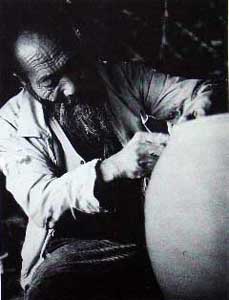History
Culture
Pottery
Traditional Music
Traditional Clothing
Traditional Houses
Traditional Dances
Traditional Painting
Food
Tourism
Merchandises
|
Pottery
Pottery is shaped from clay then fired in high temperature kilns. They are usually fired once on 800-900ºC heat, glazed with enamel, then fired again on a higher temperature of 1,300-1,500ºC It is unique in that it produces a clear sound when tapped and has a clear sheen. The first documented usage of clay in the Korean peninsula was during the Neolithic era. By the Age of the Three Kingdoms (B.C.57-A.D.676), earthenware use in everyday life was common on the peninsula. |
 Pottery-making |
During the Unified Silla Kingdom (676-935 A.D.), the shape of a earthenware diversified and began to carry up the decorative patterns. |
During the Goryeo era (918-1392 A.C.) earthenware culture evolved into ceramic ware culture. Created by glazing and re-firing once baked earthenware, ceramic ware was superior in its durability, ease of use and impermeability against water. With the creation of the 'cheongja', a type of clear, pale green hued ceramic, the Goryeo era cemented its place in history as the golden era of Korean ceramics culture. Of the 'cheongja' ceramics, those made using the 'sanggam' method (intricate designs were carved into the vase, and other materials added to the forms) are especially prized for their artistry and beauty- the pinnacle of ceramic making. |
Later in the Joseon era (1392-1910), white ceramics called 'baekja' and 'buncheongsagi' made an appearance. Joseon era ceramics were simple in design than in Goryeo era counterparts and it was during this time that ceramic making techniques were transferred to Japan. |
In modern times, the ceramic making tradition is continued in Icheon, Yeoju, Gwangju, Danyang, Mungyeong, Hadong, Gangjin, and Buan's ceramic villages ('dochon'). Of these, the Icheon Ceramics Village is the largest, occupied by the factories of over 80 companies. Every two years, the World Ceramics Biennale is held as well. For those wishing to stay within Seoul, the Insadong street also has a diverse collection of ceramics on hand at any given time, from crude earthenware to the refined 'baekja'. |
During a 1999 visit, Queen Elizabeth of England expressed her delight at the artistry of Korea's ceramics that she saw in Insadong. |
The following are the types of ceramic ware that can be found and seen in Korea |
|
|
|
|
|

